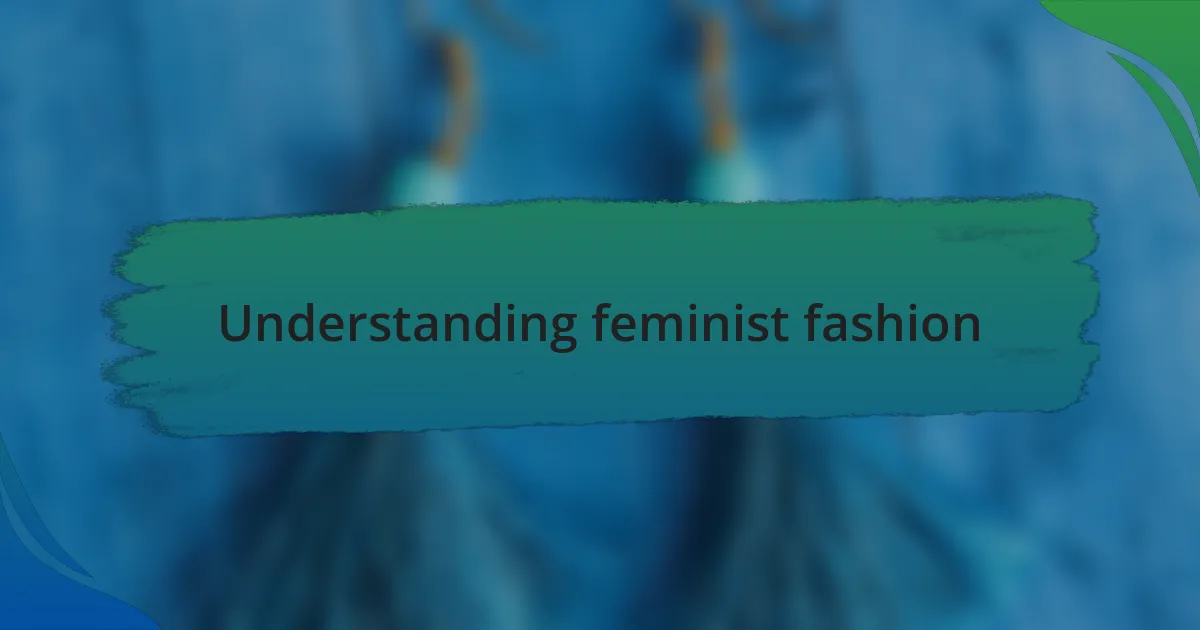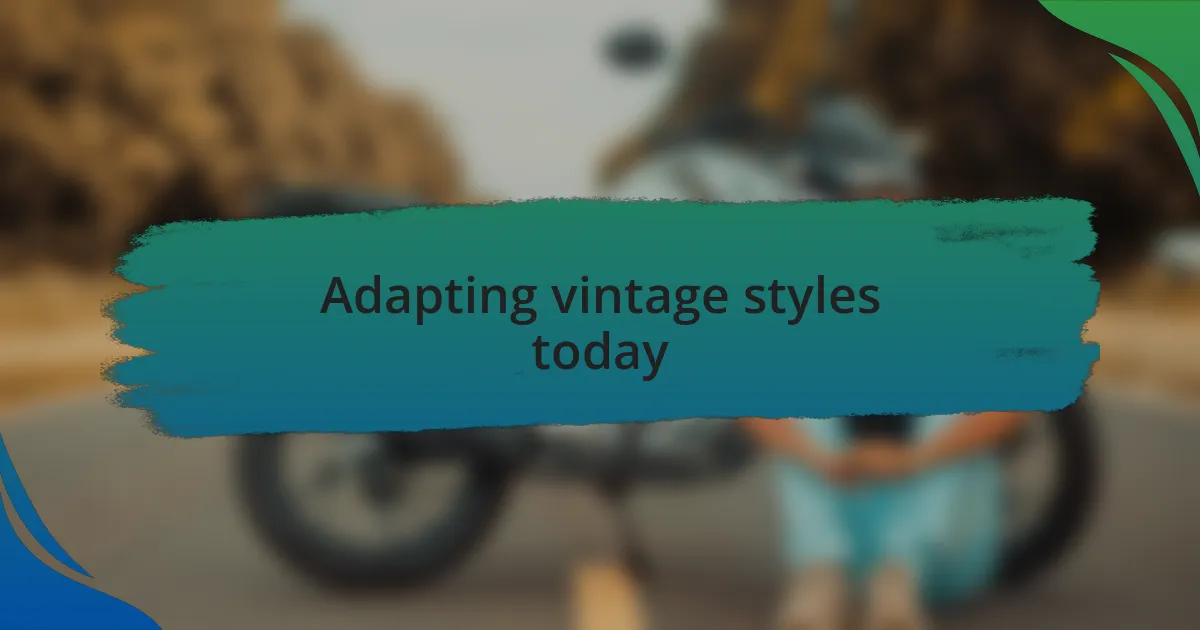Key takeaways:
- Feminist fashion serves as a powerful medium for self-expression, intertwining social consciousness with personal style and community support.
- Honoring forebears fosters a dialogue between generations, enriching understanding of the past and inspiring advocacy for gender equality.
- Adapting vintage styles and incorporating sustainable practices reflect respect for heritage while promoting individuality and ethical choices in fashion.
- Supporting women artisans and sharing stories through fashion create meaningful connections to heritage, empowering both the wearer and the creators.

Understanding feminist fashion
Feminist fashion is more than clothing; it’s a powerful medium for self-expression and identity. I remember wearing a vintage band tee that sparked conversations about women’s representation in music. It made me realize how fashion can challenge societal norms—what does your outfit say about your beliefs?
At its core, this movement intertwines social consciousness with style. I often find myself reflecting on outfits that resonate with me on a deeper level, like a handmade dress from a local woman-owned business. It’s a reminder that fashion can also support community and sustainability; isn’t that something worth considering?
Through the lens of feminist fashion, I see a rich tapestry of history and rebellion. The imagery of women donning pants in the early 20th century still inspires me today. This act of defiance wasn’t just about comfort; it was a statement of autonomy. How can we honor such bold moves by embracing our personal style?

Importance of honoring forebears
Honoring our forebears is crucial because it allows us to recognize the sacrifices and struggles that paved the way for our current freedoms. I often think of my grandmother, who fought for her right to work in a field dominated by men; her stories resonate deeply with me. Reflecting on her journey not only enriches my understanding of the past, but it also inspires me to advocate for gender equality in my own career.
When I wear my grandmother’s vintage brooch, I feel a connection to her resilience. Each time I don that piece, I am reminded of her courage in a time when women were often overlooked. This simple act of remembrance elevates my style and reinforces the importance of continuing her legacy in the present.
Honoring forebears creates a dialogue between generations, fostering a sense of belonging and purpose. How can we ignore the powerful narratives woven into our personal history? Incorporating their stories into our fashion choices can transform clothing into a canvas of empowerment and pride, urging us to push boundaries just as they did.

Adapting vintage styles today
Adapting vintage styles today means more than just wearing old clothes; it’s about reinterpreting the aesthetics and values of past eras to fit modern sensibilities. I recently came across a pair of 70s bell-bottom jeans at a thrift store. The moment I slipped them on, I felt an instant connection to the bold, free-spirited women of that decade who expressed their identities unapologetically. How can we not celebrate their spirit in our daily lives?
One of my favorite ways to incorporate vintage elements is by pairing a classic 50s A-line dress with contemporary accessories like chunky sneakers or a sleek denim jacket. This fusion not only creates a unique look but also pays homage to the decades of feminism that have shaped our current fashion landscape. It’s fascinating to think about how each piece I wear carries a story—like the way that dress embodies the strength of women who fought for self-expression in a more conventional time.
When I style vintage clothing, I often wonder how those before us navigated societal expectations through their fashion choices. It inspires me to infuse my outfits with confidence and individuality. For instance, I love layering statement necklaces from different decades, creating a vibrant tapestry that speaks to my eclectic taste while honoring the journey of those who wore them before me. Each choice becomes a tribute—a conversation between my present and their past.

Incorporating sustainable practices
Sustainable practices in fashion are essential for honoring our forebears, as they remind us of the resourcefulness and creativity of previous generations. I once visited a local artisan fair where one vendor sold bags made entirely from repurposed fabric scraps, and it struck me how these creations echoed the thrifty ingenuity of women who stitched their own clothes out of necessity. Isn’t it empowering to think we can continue that legacy by choosing to support artisans and small businesses that prioritize sustainability?
In my own wardrobe, I’ve started to prioritize quality over quantity, opting for fewer pieces that are timeless and can be styled in multiple ways. I remember purchasing a beautifully crafted sweater from a brand that emphasizes eco-friendly materials and fair labor practices. Every time I wear it, I feel a deep connection to the makers who poured their craftsmanship into the garment, marking it not just as clothing, but as a statement of ethics and respect for our planet. Isn’t it refreshing to wear something that reflects your values?
Moreover, my experience with mending has turned into a delightful journey towards sustainability. Recently, I repaired a vintage jacket that was a hand-me-down from my grandmother, transforming it into a unique piece with my own personal twist. This process not only breathed new life into an old garment but also deepened my appreciation for the stories each piece can tell. How about trying your hand at mending? You might discover a new way to connect with both your wardrobe and the women in your lineage who valued resourcefulness and sustainability.

Showcasing women artisans
Supporting women artisans is one of the most heartfelt ways I honor my forebears. Recently, I stumbled upon a group of women in a community workshop who were creating intricate jewelry pieces. As I listened to their stories, I felt a strong connection to the generations of women before them who wove their artistry into everyday life. Does it not inspire you to think about how this craft carries the spirit of resilience and creativity through time?
One afternoon, I attended a showcase featuring textile artisans, where each piece narrated a story of its own. I remember chatting with a woman who passionately explained the techniques handed down through her family. It struck me how these traditions are not only art forms but also pathways for empowerment and financial independence. Can we really appreciate fashion if we overlook the hands that have shaped these beautiful creations?
Every purchase I make from a woman artisan transforms the transaction into a meaningful celebration of heritage. I recall buying a hand-painted scarf from a local market, and each time I wear it, I feel like I’m enveloped in a tapestry of history and culture. Isn’t it powerful to know that by supporting these artisans, we are contributing to the preservation of their crafts and stories?

Creating personal style statements
Creating a personal style statement often begins with reflecting on the stories behind our clothing choices. I remember an old dress I inherited from my grandmother. Every time I wear it, I’m not just putting on a garment; I’m wrapping myself in her legacy, carrying forward her spirit and strength. Doesn’t it make you wonder how our outfits can echo the journeys of those who came before us?
Sometimes, I experiment with accessories that tell a story. I once found a necklace made from repurposed materials, crafted by a local artist who shares a similar background to mine. Wearing it sparks conversations, and I cherish how these pieces connect me to the past while carving out my unique identity. What if each item in our wardrobe had a voice, sharing tales that bridge generations?
In my journey, I’ve also learned the importance of intentionality in selection. I consciously choose fabrics and designs that resonate with my values, such as sustainability and ethical production. Once, at a thrift store, I discovered a vibrant jacket with a patchwork design that reminded me of my ancestors’ resourcefulness. It’s incredible to think that each choice not only shapes my style but honors the creative spirit of those who have influenced it. How do your wardrobe choices reflect the values you hold dear?

Sharing stories through fashion
Fashion has an incredible ability to convey stories, often without a single word being spoken. I once wore a handmade skirt passed down from my great-aunt, adorned with intricate patterns that speak to her artistic soul. Each time I don it, I feel an unspoken connection to her creativity and resilience, making that piece not just clothing but a chapter of my family’s narrative. Hasn’t there been an outfit for you that felt like it held a memory just waiting to be explored?
The shoes I wear often tell a tale of their own; I have a pair of vintage boots that remind me of my mother’s youthful adventures. Whenever I slip them on, I can almost hear her laughter and feel her courage, as she navigated a world that often sought to silence her. It’s astonishing how footwear, seemingly mundane, can symbolize bold journeys, encouraging us to step into our own stories.
I also cherish garments that showcase the artistry of my heritage, like a vibrant shawl woven by artisans from my hometown. When I wrap it around my shoulders, I’m not just embracing style; I’m honoring the collective spirit of those who crafted it with love and care. What stories do your clothes tell, if only we pause to listen?